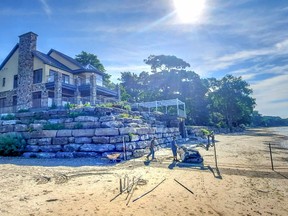
Reviews and recommendations are unbiased and products are independently selected. Postmedia may earn an affiliate commission from purchases made through links on this page.
Article content
Waterfronts are magical, they should be public for all to enjoy
Advertisement 2
Article content
Despite Canada’s reputation as a country blessed with an abundance of nature, far too many cities and towns have a shortage of parks and public space.
It’s a shortcoming that negatively impacts both the physical and mental health of residents in these communities; especially in more disadvantaged neighbourhoods where there is often a lack of green space to begin with.
To address that problem, a growing number of forward thinking planners and civic leaders are exploring ways to add more places to play through such measures as transforming parking lots into parks.
But sometimes the biggest community challenge isn’t about the lack of amenities, but access to them.
A prime example of that sadly, can be found in Fort Erie where we live, where for years, waterfront landowners have tried to block access to Lake Erie beaches by erecting fences that run out to the water line.
Article content
Advertisement 3
Article content
Earlier this summer I encountered two workers on the local beach who actually apologized for installing two barriers they were being paid to erect by the owner of a massive waterfront home.
The fences are designed to deter residents from walking along the beach while boxing them into a narrow public beach “window” as the town calls them.
After reaching out to local officials, I learned that due to the lack of oversight of their predecessors decades ago, some of the homeowners actually do own the beaches right down to the high water mark of Lake Erie, sometimes right into the water.
Through additional research I also discovered that the area’s previous local MPP (Kim Kraiter) had tabled a private member’s bill known as the “Great Lakes Shoreline Right of Passage Act” back in 2011.
Advertisement 4
Article content
The overarching goal of that proposed legislation was to reverse laws – some of which go back over 100 years, so that residents and visitors are given a “right of passage” along Great Lakes beaches.
Sadly that bill died on the table – in my mind -a prime example of our MPPs looking after the interests of a select few versus the general public.
In the latest twist to this saga, I’ve been informed that local politicians are exploring the legalities of preventing waterfront homeowners from erecting fences in the first place.
As someone who fully supports the success of this endeavour (and I suspect most locals feel the same way) it will be interesting to see how this plays out.
So what is the takeaway from all of this?
To paraphrase a recent LinkedIn post by Toronto-based urbanist Gil Penalosa, “waterfronts are magical (including) along rivers, lakes (and) creeks. God’s gift to everyone. They should be public for all to enjoy.”
Advertisement 5
Article content
Expanding on this notion, he observes that a “great indicator of a quality city is all that is free (including) trails, parks, sidewalks… libraries (and) schools.”
Conversely, in communities where people’s access to such amenities as a Great Lakes shoreline is restricted, the quality of living of those residents is compromised.
Despite Canada’s lofty position as Global North, G8 member… countries like Barbados do a much better job of promoting access to such amenities as public beaches.
As the country’s website states “there are no private beaches in Barbados; all beaches are public (and) properties which front onto a beach may own the land to the high-water mark only.”
Consequently, everyone is entitled to walk along the beach, enjoy the setting and in the spirit of Ontario’s own Participaction program, stay active.
Advertisement 6
Article content
The argument in favour of opening up our Great Lakes beaches to the public is a subset of a more universal concern in many of today’s cities – the lack of infrastructure to make it safe to walk in the first place.
To its credit, last year councillors in Thorold, another Niagara Region city, expressed concern for residents vis-à-vis new residential developments due to the absence of sidewalks and greenspace in the initial plans, a shortcoming that is endemic in our cities.
Toronto for instance has hundreds of kilometers of roads without sidewalks. And both the safety and economic numbers associated with an absence of sidewalks are telling.
In Ottawa, the city’s previously published Pedestrian Plan notes that “residential areas with no sidewalks had 23 per cent of the pedestrian collisions but only 3 percent of the pedestrian traffic (and) compared to the overall sample of streets, local streets without sidewalks had 2.6 times more pedestrian collisions than expected.
Advertisement 7
Article content
In other words, people walk less in areas without sidewalks and unsurprisingly, are more likely to get hit by oncoming vehicles.
Conversely, despite the focus of some levels of government on building more roads for just cars rather than allocating some of that money for sidewalks, the plan points to numerous savings that can be associated with having more sidewalks, which in turn makes walking safer and more desirable.
Benefits cited include: lower vehicle ownership costs (thanks to people using their cars less), fewer vehicle-related emissions (and with that, improved air quality) healthcare cost savings (realized by having a more active community) and economic benefits for local businesses. All benefits linked to having a more pedestrian-friendly city.
Whether it pertains to a local beach or along a street that connects you to other public amenities, if we want to create healthier, more vibrant communities, we need to make it both easier and safer to, walk on by.
Mark Wessel lives in Ridgeway, Ont. and is an advocate for living more sustainably at home and in the greater community. Visit him at www.markdouglaswessel.com.
Article content
